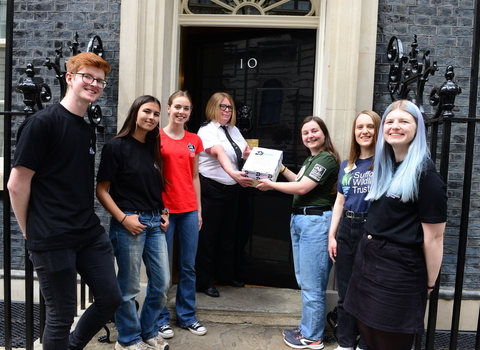What is a petition?
A petition is a formal written request by members of the public on a particular issue which calls for some form of action by the recipient (e.g. a business, or local authority.) It usually requires a certain target number of people to sign the petition to show the recipient how much support there is behind the cause, and has a clear ask or actions to be taken in response.
Before starting the petition process, there are a few things to consider:
- What is the issue?
- What do you want to change?
- Why is it personal to you?
- What are you asking for? And from who?
- Why should other people support this?
Summary of tips
1. Check if your petition requires certain wording to be included e.g. “To the Houses of Common” and “The petitioner(s) therefore request(s)/ urge(s)”
2. It is important to check the requirements of your petition recipient to make sure they will accept the platform your petition is hosted on. Some will only accept a petition hosted on a certain platform.
3. Write your petition as if someone with no previous knowledge or experience of the issue is reading it. Avoid acronyms or technical language unless you explain it fully.
4. Remember to include the petition organiser’s contact details so that the recipient can respond
5. People signing your e-petition must confirm the verification email in order for their signature to be counted.
Structure of a petition
Petition Title - something that includes key information with an action verb and name specific people, places or organisations.
Description - a sentence to briefly explain the purpose of the petition
Main Body - provide more context to the issue and answer the who, what, where, why and how questions. Summarise 2-3 main points.
Evidence - include an expert/report/policy/data that supports your opinion
Asks - what are you asking for from the petition recipient?
Impact - what will happen if the supporters/recipients don’t act? What will happen if they do act?

Step One: Select the recipient of your petition
Who is your petition going to be addressed to? And why?
Get an understanding of the key stakeholders involved in your issue such as the local council(s), MPs, community groups, schools, businesses, faith groups, charities, and members of the public. Decide who will be the most effective person or organisation to receive your petition. Who has the power to make this change?

Step Two: Find out the requirements for your petition
Once you know who is going to receive your petition, research what are the requirements for your petition to be accepted. There are a few starting points to consider and research:
- What is the minimum number of signatures needed?
- Have you clearly stated the topic being addressed and the action required?
- Identify the petition organiser (e.g. yourself or a community group)
- Who is allowed to sign the petition? And what evidence may be needed to validate the signatures?
- How long will the petition be live for?
- What will get the petition rejected? (e.g. inappropriate language, similarity to an issue already raised and considered in the last 6 months, or not enough signatures.)
Check if your petition requires certain wording to be included e.g. “To the Houses of Common” and “The petitioner(s) therefore request(s)/ urge(s)”

Step Three: Choose your petition platform
You can choose to either do a paper petition (whereby supporters sign in-person, and the petition is hand-delivered to the recipient) or an e-petition (whereby people sign online, and the petition is submitted digitally to the recipient.)
If you are doing a paper petition, you can create your own document or use a template, which must include space for people to sign their name, address, and signature, as well as the information in step 4.
There are lots of different platforms to host your petition online. Some are free and some will have a fee. Some are small-scale and some are large-scale. Some have functions to share your petition, and some have additional support services.
It is important to check the requirements of your petition recipient to make sure they will accept the platform your petition is hosted on. Some will only accept a petition hosted on a certain platform.
Here are general petition platforms you could use:
You can also check your local council website for their e-petition platform when they are the recipient of a petition, such as:

Step Four: Write your petition
Whether you are doing your petition on paper or online, you can follow this structure below to ensure you include all the essential information in your petition:
Write your petition as if someone with no previous knowledge or experience of the issue is reading it. Avoid acronyms or technical language unless you explain it fully.
- Petition Title – something that includes key information, start with an action verb and name specific people, places, or organisations
Example: "Ask British Sugar to help more farmers go neonic-free."
- Description – a sentence to briefly explain the purpose of the petition
Example: "Tell British Sugar you want them to support farmers who choose not to use neonics."
- Main body – provide more context to the issue and answer the who, what, where, why and how questions. Summarise 2-3 main points.
Example: "[…] British Sugar seems determined to harm nature, by regularly asking the Government for special permission to use banned chemicals - neonicotinoids (known as neonics) – on sugar beet crops. This affects the sugar we all eat every day; from the sugar we put in our coffee to sugar used in cakes, breads, ready meals, and more.
Incredibly, after requesting special use for four years in a row, British Sugar have put forward a request to use it again.
Choosing to grow sugar without neonics is the best way to a wilder future. Many farmers are trying to do this, but they need more support. Please sign our petition today!"
- Evidence – include an expert/report/policy that supports your opinion
Example: "In 2022, 29% of sugar beet farmers did not use the neonicotinoid Thiamethoxam after the UK Government approved its use. In 2023, this number rose to 40% of sugar beet farmers."
- Asks – what are you asking for from the petition recipient?
Example:. "Tell British Sugar you want them to support farmers who choose not to use neonics. They should have the opportunity to market their produce as neonic-free, and be paid a premium for this."
- Impact – what will happen if the supporters/recipients don’t act? What will happen if they do act?
Example: "Please help us gather as many signatures as possible to this petition before we hand it in to British Sugar. We plan to meet with British Sugar bosses alongside key representatives from the farming community and other experts, to share this petition and ask for their action.
You can also add your own views about why you want neonic-free sugar and more nature-friendly farming."
Ask British Sugar to help more farmers go neonic-free . View this example of an e-petition in full, created by the Royal Society of Wildlife Trusts.
Remember to include the petition organiser’s contact details so that the recipient can respond

Step Five: Collect Signatures
Now that your petition is published, it’s time to start gathering signatures. After completing step two about the requirements of your petition, you’ll know what the minimum number of signatures is needed for your petition to be accepted. Aim to get more signatures than you need.
This is because some signatures may not be valid. For example, some petition recipients require people signing to live, work and/or study in a particular area or to be a British citizen or UK resident. This will usually be validated by them ticking a box to state that they meet the requirements and then receiving a verification email to confirm.
Some petition platforms can verify petition signatures automatically.
People signing your e-petition must confirm the verification email in order for their signature to be counted.

Step Six: Presenting the Petition
Once your petition has closed and the target number of signatures reached, you can deliver your petition to the recipient. With such a volume of support behind your cause, you could do this in a way to gain further publicity.
- Handing in the petition in-person and inviting local media outlets. You can stage a hand-in photo and ask supporters to bring signs.
- Ask for a meeting with the petition recipients to give a formal presentation. This could include speeches from the petition organiser and supporters.
- Write a press release to share with local media outlets about petition, number of signatures collected, and the asks. You can also add if there is an update on the outcome e.g. a meeting has been scheduled or the recipient has agreed to the petition asks, then include this.
- Share your story. Keep your petition supporters informed and interested in your cause with updates and post on social media to share.
Ask your local MP to present your petition on your behalf in the Houses of Common through either a formal or information presentation.



